Are you looking for a list of LSI keywords so you can find relevant search terms to add to your content? This is a complete guide on how to move up in Google’s search results based on what people are looking for.
LSI is the constant search engine optimization term and part of the Google algorithm. This is of crucial importance in its implementation as per the SEO strategy. This post teaches you how to find LSI keywords, how to use LSI keywords in your blog post optimization, and where to get these LSI keywords.
Table of Contents
LSI Keywords: Why these keywords?
LSI keywords meaning is latent semantic indexing. This is the idea that is used to figure out how terms and ideas in content relate to each other. Simply put, keywords are words to use in the content search on Google.
LSI is an LSI-based semantic search engine that provides semantic information about a specific phrase in the dictionary based on the LSI. When one of the primary keywords for your webpage is the credit card, LSI keywords could include anything like money,” credit ratings”, credits limits, and interest rates.
They are not similar words (different words mean different things) though. It is closely linked to each other that help identify an issue on an online website. In semrush, we use “semantically related words”. Google is no longer searching websites for keywords but is now indexing them using the same keywords that are used in the past.
LSI keywords definition is
“These are the related keywords to the main keyword.” Most search engines understand the link between the entire web content.
From an SEO perspective, using LSI keywords is very important. They are words or phrases that are similar to or closely related to the main keyword for the specific keyword. It increases search relevancy. The definition of LSI keywords states that they are the keywords that are semantically related to your target (or focus) keyword.
But they are not synonyms. Unfortunately, most people wrongly assume that LSI keywords are synonyms. These keywords are thrown together as they share the same context but not the same literal meaning.
Google scans your web page to see if you’ve used LSI keywords. This is because these extra keywords add information that isn’t shown by the main keyword alone.
There’s no doubt that when you write in-depth about a subject, you should use synonyms and words with similar meanings. Some LSI words are given below for easy understanding.

- Example 1: If you are writing an article on cars, include keywords including engine, machine, wheels, interior, Mercedes, Audi, and KMPH. Through this, Google will understand that you are writing an article on cars (vehicles).
- Example 2: If you are focusing on “online mobile” keywords, “mobile prices”, “online mobile reviews”, and “mobile tech specifications” can be similar keywords to the root keywords.
- Example 3: The LSI makes better sense for the single keyword. If you take the keyword “Apple,” how does it differentiate whether Apple is a fruit, Apple is a brand, or Apple is the name of any pet? Here the Google search for LSI (latent semantic indexing) words for their understanding. If they find words like “fruit,” “taste,” and “flavor” in the content, then it would be easy to understand the article about Apple Fruit. Here, fruit, taste, and flavor words are LSI words for “apple.”
In old-school SEO concepts, keyword stuffing is more popular to rank pages on Google. Now, Google has come up with this LSI (latent semantic indexing) idea for how to use keywords to make sites more relevant.
Difference between LSI Keywords vs Long tail Keywords (LTK)
If you are looking for ways to increase your website traffic, you might have come across the terms LSI keywords and long tail keywords. These two types of keywords can help you optimize your content for search engines and users. But what is their difference, and how can you use them effectively?
LSI keywords are words or phrases semantically related to your primary keyword. They help search engines understand the context and meaning of your content. For example, if your main keyword is “an apple,” LSI keywords could be “fruit,” “iPhone,” “pie,” “cider,” etc. LSI keywords can also be synonyms or variations of your primary keyword, such as “apples,” “apple products,” “apple company,” etc.
Long tail keywords are longer and more specific versions of your primary keyword. They usually contain three or more words and have lower search volume and competition than your primary keyword. For example, if your main keyword is “an apple,” long tail keywords could be “apple pie recipe,” “best apple cider brands,” “how to fix an iPhone screen,” etc. Long tail keywords can help you target a specific audience or niche and rank higher for their search intent.
The main benefits of using LSI keywords are:
- They can improve your relevance and authority for your primary keyword.
- They can help you rank for more related queries and variations of your primary keyword.
- They can reduce the risk of keyword stuffing and over-optimization.
- They can enhance the readability and user experience of your content.
The main benefits of using long-tail keywords are:
- They can help you attract more qualified and converting traffic to your website.
- They can help you rank higher for less competitive and more profitable keywords.
- They can help you address your audience’s specific needs and problems.
- They can help you stand out and create a unique value proposition.
It would be best if you did keyword research and analysis to use LSI and long tail keywords effectively. You can use tools like WebCEO’s Keyword Tool or Scalenut’s Content Assistant to find relevant LSI and long tail keywords for your topic. You can also use Google’s autocomplete and related searches, and people also ask for features to get more ideas.
Once you have a list of LSI and long tail keywords, you must strategically incorporate them into your content. You can use LSI keywords in your title, headings, subheadings, introduction, conclusion, body paragraphs, image alt texts, meta tags, etc. You can use long tail keywords as your primary focus or as secondary keywords in your content. You should also make sure that your content is well-written, informative, engaging, and provides value to your audience.
Using LSI and long tail keywords in your content can improve your SEO performance and increase your website traffic. You can also create a better user experience and build trust and loyalty with your audience. Remember that LSI and long tail keywords are not mutually exclusive but complementary. You can use both keywords to create a comprehensive and effective content strategy for your website.
Where to Use LSI Keywords?
If you use these LSI (latent semantic indexing) keywords right, they will help both users and search engines. It also makes it more likely that you will rank for other high-volume keywords that are related to your search query in a logical way.
- In the title, the tag creates a compelling feeling.
- Permalinks
- Meta tag
- First and last paragraphs
- Within the body’s content
- You can use it as Anchor text to link other pages or posts
- You can use it as ALT text, as a filename, and as titles of images
- You can use the page title to support your target keyword
Note: Adding more LSI words gives spammy results. So, take care of the LSI word sprinkling. It gives more SEO-friendly results than normal results.
Advantages of LSI Keywords and Their Usage
If you use LSI keywords in your web content, you will gain more benefits. The following are some of the most significant advantages of using LSI Word.
After the Hummingbird algorithm change, LSI (latent semantic index) became so popular. It helps with effective search engine optimization.
1. Protects from Content Spamming
- The LSI Words help you to prevent the spamming mark from search engine analysis.
- It increases the content’s credibility.
- It helps you to differentiate your content from spun content.
- It helps you to avoid keyword stuffing and indirect search manipulation.
2. If relevant keywords are not used, the bounce rate decreases. Why?
- It helps you reduce bounce rates.
- It protects your site from ranking for the wrong terms.
3. Increase page spending time of the visitor
- These types of keywords improve the readability of the content.
- This improvement gives a better content environment for the reader without making it feel keyword stuffed.
- It improves visitors’ spending time on your pages.
4. Improve Search Engine rankings
- These keywords help you rank your blog posts for related searches.
- Google search bots identify your blog content, and it crawls easily.
- Google uses an LSI strategy to rank your site. Here, the ranking factor is not dependent on your target keyword.
5. Useful for Blog Authority Improvement
- It helps you improve your blog authority.
- More Ranking gives more CTR.
- More CTR gives More Blog Authority.
6. For Better Sales
- Sometimes you can use these LSI words as LT keywords.
- By using these keywords, you can rank higher without having low competition.
- It depends on most of the Amazon shopping site sales on LSI Keywords.
When did LSI keywords become relevant?
LSI keywords started appearing in Google’s search engine algorithms from 2004 onward. It is intended to aid Google in improving its search engine rankings. Google provides useful data. However, Google was not limited by keyword searches.
The search giant aims primarily at understanding anchor texts and group links between sites, also called search engine neighborhoods. Google has dramatically changed search engine performance by introducing a new algorithm.
Search engines do not now focus on keywords matching a keyword on websites.
Impact of LSI keywords on SEO
In its early days, the Google crawler was used to search for and crawl web pages through the use of links on linked websites. As they crawled, they looked at the keywords on the pages and identified their subject matter.
If you are to publish an eBook on how to use email segmentation to build your email marketing campaign, you will have used this terminology in other sections, such as :
How to Use LSI Keywords for Better ranking in Search engines?
This is the biggest secret in the SEO industry. Most bloggers and marketers are inserting keywords into the content without any strategy.
The ranking of the blog post depends on the placement of LSI keywords. If you are not using it correctly, your ranking will be affected. You can use 2 to 3 LSI keywords per 100 words in the article.
Here I am providing a few tips to make better SEO
1. Choosing a good Keyword
The LSI tools mentioned above generate LSI keywords based on Google’s algorithm. So most of the keywords are not related to the primary or target keyword. You need to filter out useless keywords from the list. That means, picking the relevant keywords.
If you get more LSI keyword lists from different tools, there are more likely to be repeated phrases in the lists. Therefore, you need to remove those duplicated keywords.
2. Place the keyword naturally
Placing relevant and good LSI keywords within the content is very important. If you use it unnaturally, it may be harmful to your site’s SEO. Do not add all the generated LSI KWs into a single article. It is too dangerous.
Pick relevant phrases that are similar to the list; place them naturally within the content. Sprinkle the keywords into your content in a meaningful way. If you add it in this way, your blog post gets a better ranking.
3. Choose and add more targeted positions
Use the keywords in the following targeted locations without missing them.

These places appear naturally and give better readability to the reader.
4. Focus on user experience
Do not overuse keywords. Although these may not really be your keywords, you can always overuse them; you could face sanctions for that.
You should provide enough relevant words so that Google can see exactly what is going on with your website but not ruin the experience. The best way to do this is to add relevant words to make sure the content is consistent, sounds natural, and is easy to understand.
Google has started using two advanced algorithms, namely Hummingbird and Rankbrain. The hummingbird is the memory unit. It listens to the search queries and reads the web pages and the schema to create an entity base. That’s why Google does not rank web pages but only entities.
This allows you to improve visitors’ experiences and make a bit of money through blogging.
Best Sources to Get Latent Semantic Indexing Keywords
To get LSI keywords, there are many research tools available on the web. Here I picked a few online tools and WordPress plugins, and I’m using these keyword generator tools for my content development.
I give our top recommendations for finding LSI keywords below. Let them check them now.
1. SEMrush

SEMrush is an all-in-one digital marketing package with many professional tools like SEO, PPC, and keyword research. In layman’s terms, bloggers and other digital marketers use the SEMrush tool to drive more website traffic and revenue. Get SEMrush’s free trial for 14 days.
SEMRUSH is one of the biggest keyword research and keyword spy tools. You can use this tool to spy on your competitors using keywords. This tool makes your keyword research process very easy.
It uses the perfect keyword strategy to organize the keyword database for the search phrases that are similar every time. After collecting those keywords, you can add LSI keywords to the content.
The Semrush helps you with these.
- You can spy and pick your competitor’s best-performing keywords.
- You can analyze your blog and competitors’ backlinks.
- You can estimate the blog traffic.
- You can analyze and get the best topic ideas with the topic research tool.
- By using the Web site audit feature, you can find and fix on-page-related issues in your blog posts.
- You can check the domain-to-domain comparison here.
- You can find the most profitable keywords for any niche.
- You can create a complete marketing plan with an SEO content template.
- You can write awesome content within the SEMrush SEO writing assistant dashboard.
2. LSIGraph

LSIGraph is a free tool and it is designed to help you choose and pick dozens of related phrases to use within your content. These are semantically related keywords for your SEO and paid marketing needs. The semantic keywords will give better readability and understanding of the search engines.
LSI is a natural language processing technique. It was developed in the 1980s.
The usage of these keywords is very simple. Just pick the best LSV and use it throughout your content, anchor text, and backlinks. After a few hours, you will see an improvement in the SERP.
The LSIGraph is available in two versions: free and premium. You will have limited keyword searches – 3 keywords only. In these 3 free searches, you will find a bunch of keywords with the trending graph, search volume, CPC, and competition.
After that, you have to upgrade your plan to the premium for these extra features. In the regular LSI keyword phrases, you can use the free version after the daily 3 searches without Trending features.
The premium version begins at $15 per month for unlimited searches. This is one of the most straightforward and best free keyword research tools
It is a handy tool to get the right latent semantic keywords.
Learn How to find keywords by using LSIGraph?
- To use the related keyword generator tool, go to the official homepage.
- Enter the primary keyword in the search box and solve the captcha, then click on the Generate button.
- Finally, you will get two different results. They are LSI Keywords data in the keywords section and its top-performing content pages.
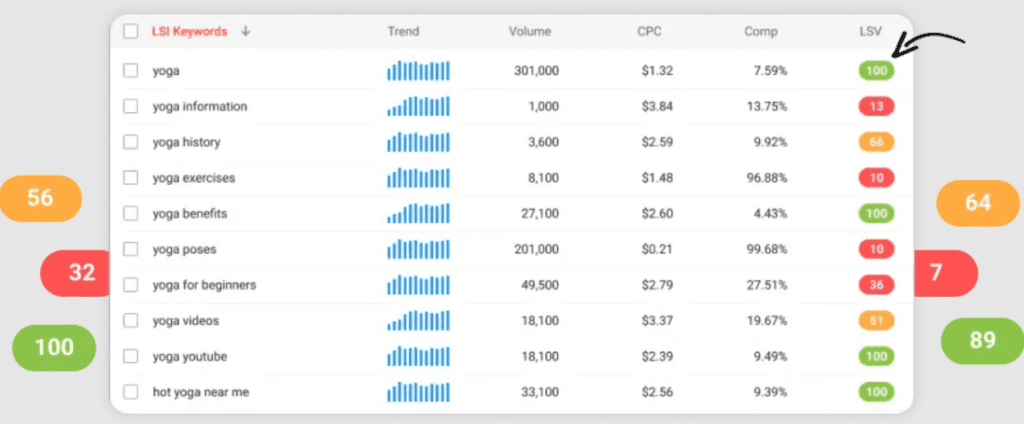
3. Google ‘AutoComplete’

Google Autocomplete is one of the fantastic services to get very good keywords. It allows users to complete their searches when they start typing a few letters. It is available in the search box in the Google app for iOS and Android and in all Google apps.
In the Chrome browser, it is available as the “Omnibox feature”. You can use this default chrome feature to get LSI keywords.
The autocomplete feature is powered by RankBrain. It is one of the parts of Google’s machine-learning search algorithm.
Google Autocomplete is another great way to find related keywords to use within your content, and it takes just seconds. Head to Google and enter your main keyword but don’t hit search.

Instead, take a look at the autocomplete results that are returned. Analyze People Also Ask Results Just as related searchers on Google can be a great way to find related keywords to include within your content, you can also analyze the People Also Ask results for further ideas.
By using this tool, you will get a bunch of relevant keywords for your content. These give popularity and freshness to your content.
When you enter one keyword in Google, the search bar fetches the relevant keywords in the drop-down menu. The same fetching keywords will appear at the bottom of the page as well.
Analyze People Also Ask Results Just as related searches on Google can be a great way to find related keywords to include within your content, you can also analyze the People Also Ask results for further ideas.
These are Google LSI Keywords.
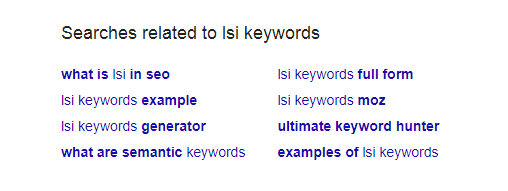
4. UberSuggest

Ubersuggest is the perfect tool to get great keyword ideas and related keywords including LSI Keywords.
Mr.Neil Patel bought a Ubersuggest tool in February 2017.
Ubersuggest is one of the best tools for finding LSI keywords and making LSI keywords. It is available in both Free and premium versions.
By using this tool, you can get all the Google autocomplete keywords for your main keyword.
It is a simple and powerful tool to get similar and relevant Keywords for better SEO.

5. AnswerThePublic Tool

AnswerThePublic is a unique keyword tool that lets you see search results like search questions and suggested autocomplete searches. Relevant words can be found in raw search data and in what your customers are thinking.
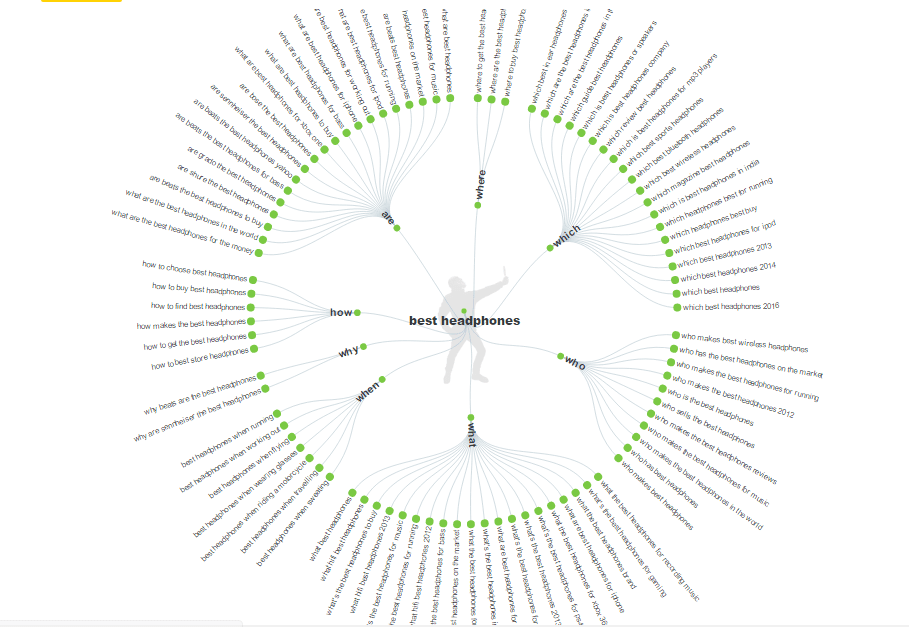
For LSI keyword research, AnswerthePublic is the best visual keyword research tool. It makes it simple to find less competitive LSI keywords.
6. BlogPatcher

Blogpatcher is yet another fantastic LSI keyword generator tool for improving site optimization. It is one of the most user-friendly tools for optimizing your content for both people and search engines. This data-driven SEO analysis tool employs cutting-edge AI and machine learning for the blog, blog posts, or article analysis.
This tool comes with three major services. They are Page Analysis, Keyword Analysis, and Site Audit Services.
Features of blogpatcher:
- Automatic analysis: When a user enters a URL and a focus keyword, this tool will automatically analyze everything and make recommendations for how to improve Google’s ranking.
- Keyword Analysis: If the user requires keyword details, this tool provides the best recommendation, which aids in ranking high in Google by analyzing the data from their top 10 competitors’ SERPs.
- Competitor analysis: This feature allows you to compare the SEO and content of your competitors’ pages and analyze them.
- Suggesting LSI and related keywords: Free WordPress plugin: The Free Blogpatcher WordPress plugin allows you to analyze your content from within the WordPress backend.
- Free WordPress plugin: The Free Blogpatcher WordPress plugin allows you to analyze your content right from your WordPress dashboard.
Grab the account and get 100 credits free and start to analyze your pages immediately. You will rank higher in Google than your competitors. The perfect tool for awesome LSI Keywords
How to use the Blogpatcher SEO tool?
To use this tool, you have to create a new account. This tool comes in free and premium versions. In the free version, 100 credits will be added to your account after signup.
If you need more you must purchase additionally.
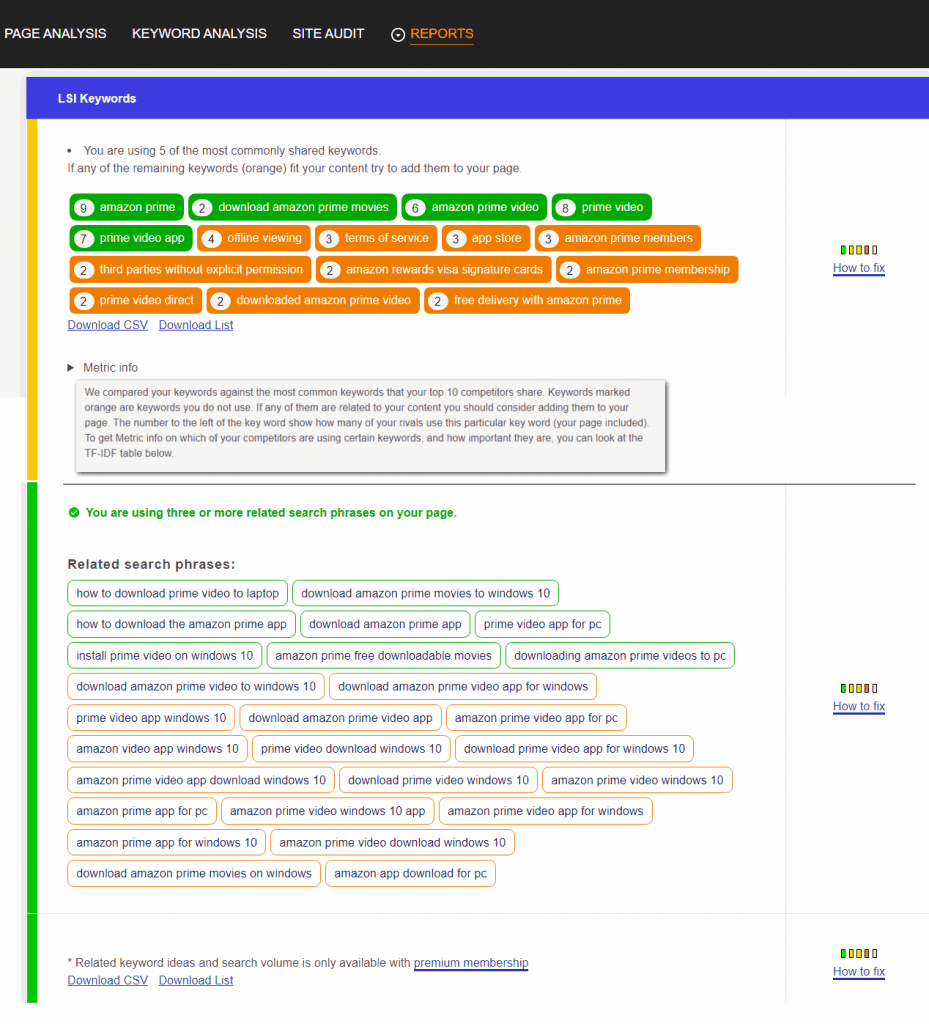
- First, create a new account by visiting the link here. You will be credited with 100 points.
- Install the Blogpatcher WordPress SEO plugin on your WordPress blog.
- Open the page in editing mode for optimization, and connect the blogpatcher account. Then start optimization as per their suggestions after your page analysis.
- They will provide an awesome list of LSI keywords and related keywords. Place those keywords within your content as per their analyzed suggestions.
- Finally, update the content and submit the URL to Google Search manually by using the Link Inspection tool in the Google search console.
LSI Keywords are not synonyms
This should not mean the LSI keyword is not synonymous with any other word. Synonyms are words that mean similar things to one another and are inserted in their place. However, in themselves, certain synonyms have little context.
One example of a synonym that has no meaning is the term “fall”. Depending on what you look at, it might mean summer and fall.
It is very hard to tell from the context of an expression alone. Add semantic words and it’s easy to understand. The term “fall” is pronounced when other words on the page include something like a leaf, tree, etc.
This is not a synonym, but it is a related word that comes from it and shows what it means. Although technically not “LSI keywords,” many people in SEO still refer to adding related words and phrases to a page as “adding LSI keywords” (even though the term is technically inaccurate).
Keyword Density In the early days of SEO, keyword density was one of the primary ways to determine the search ranking of a web page. In simple words, keyword density is the percentage of times a keyword or phrase appears on a web page compared to the total number of words on the same page.
Frequently Asked Questions on LSI Keywords
What are the LSI keywords?
How to find the LSI Keyword List? LSI keywords are words or phrases which have a semantic link with a specific topic (or the seed keyword). LSI words could include automobile, engine/road, tire/vehicle, and automatic. Using LSI keywords in your content helps Google understand the exact topic of the webpage and proves to them that the webpage is relevant to the search query.
What is the LSI keyword in digital marketing?
The buzzing digital marketing word translates into a linguistic index that is not quite so confusing. LSI keywords simply are terms that are often related to or matched with a primary keyword that is used for searches. Using LSI keywords in your content helps you rank higher on Google
How do I find my LSI keywords?
LSI keywords can be found easily on the Internet through search engines. You may search for specific keywords on Google to find them. In Google searches such as “website”, you will see keywords.
Why are Related Words and Phrases On a Page Important?
In the early days of SEO, Google, and other search engines would figure out a page’s topic-based 100% on the keywords they found on the page.
Why Are LSI Keywords Important for SEO?
LSI Keywords allow Google to determine the context & topic of your page. And when Google understands what your page is about it will trust you more -thus giving you credit for being relevant for that topic and rewarding you with an SEO boost.
Final thoughts LSI keywords
Using LSI terms is the art of blogging. If you use it as SEO-friendly and in a natural manner, the results will be surprising.
Using more of these keywords in a single piece of content leads to content spamming.
LSI also known as latent semantic analysis has evolved into linguistics techniques for identifying the context of the meaning of a word. Latent semantic indexing allows identifying hidden relationships between word semantics to improve the understanding of “indexing”.
Understanding what’s on each page can help you figure out what the site’s language is about. It seems reasonable for Google to use the technology in the context of identifying synonyms and how they are applied to content to help the search engine understand it better.
Content with the same meaning or similar words is easy for both readers and Google to understand.
Are you using LSI keywords in your articles? If so, mention the tool you are using in the comment section for more discussion.


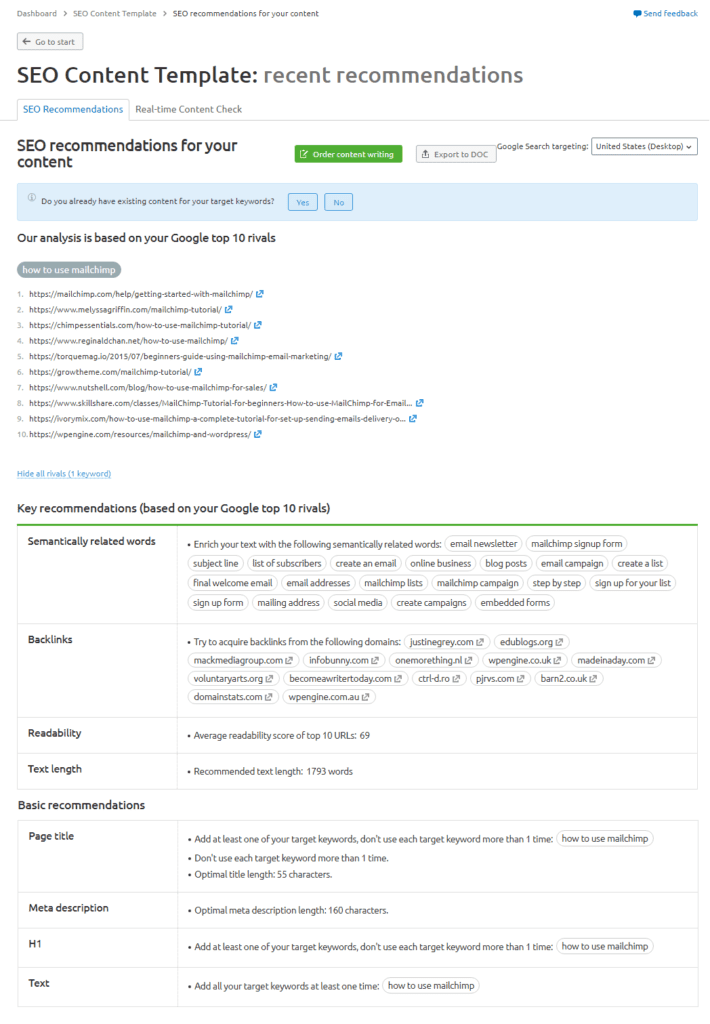






Hello Satish,
it’s really nice guide.
If to be honest I didn’t know what LSI means before I read your post.
You provided the great guide.
thanks for the info.
Hi Satish,
Great post with LSI keywords.
Using LSI keywords helps Google to understand what the content is all about and you can also rank for the related LSI keywords as you said.
Using this gives thumbs up signal to Google.
The best part is the mentioned tools like LSI Graph helps you in more content opportunity.
Thanks
Hello Satish Ji,
Today’s post about LSI keywords is highly useful and informative for prospective bloggers.
The information you have given is comprehensive and it fulfils the needs of the bloggers as far as the LSI keywords are concerned.
You worked hard for this post.
Thanks for this information.
I look forward to seeing more useful and informative posts on your blog.
Please write on “how to get Google Adsense approval Quickly” if possible.
Regards.
Venkateswararao Sangam
Hello, this has been a really nice post.
I was unknown about all these.
Thanks for letting me read and understand this.
I wonder sometimes how much time do you require to post one article.
Like I am not that used to designing and stuff.
But things look good on your blog.
Regards
Prasad
Hello Prasad,
Thanks for landing here.
I am planning article writing and posting as per my blogging schedule.
1. Keyword research and keywords collection – 1 to 2 hours
2. New Article Writing – 6 to 7 hours
3. Optimization, post designing, and image designing – 8 to 10 hours.
Total I am spending hours nearly 15 to 19 hours
Total spending time is 2 to 3 days
This is my schedule.